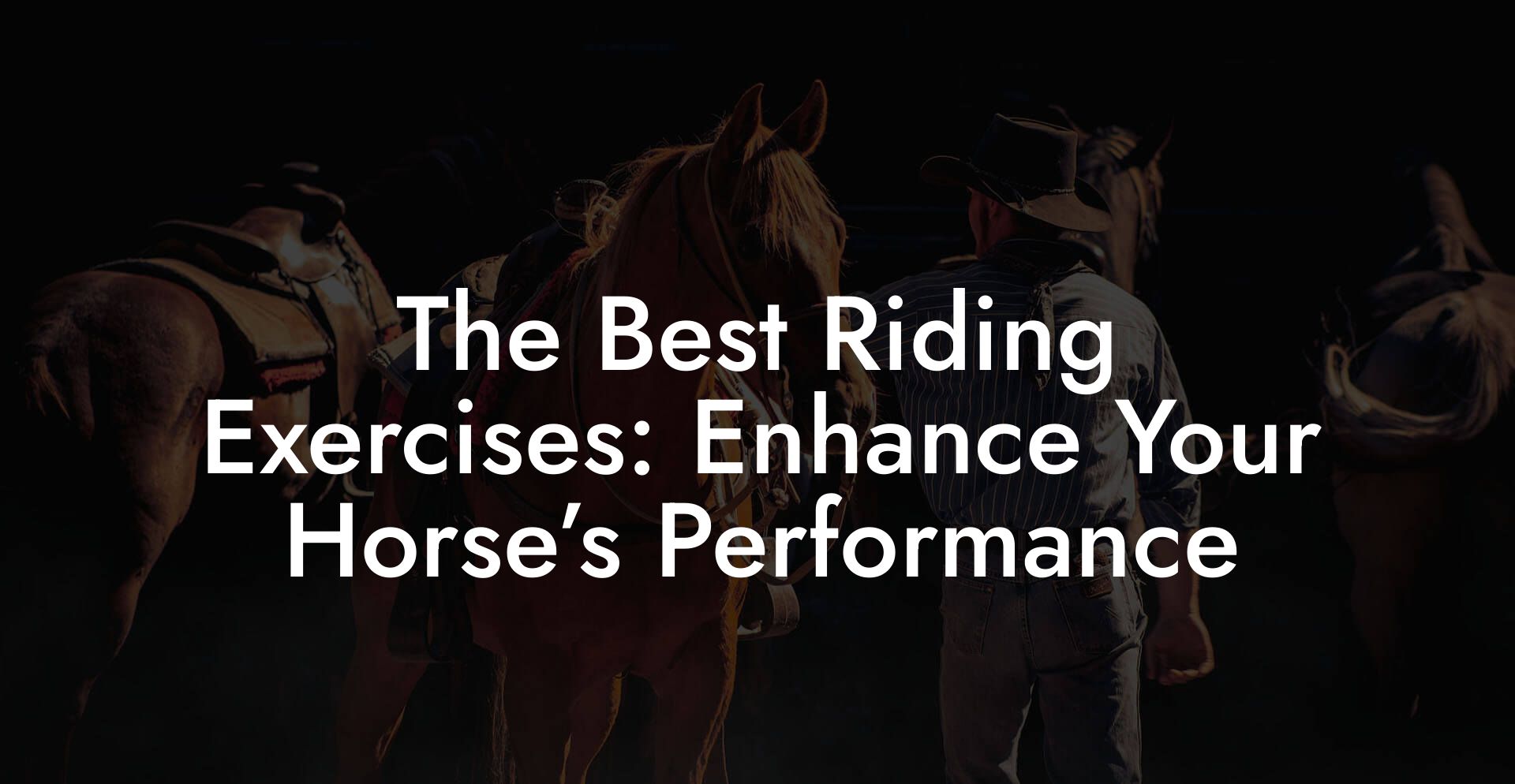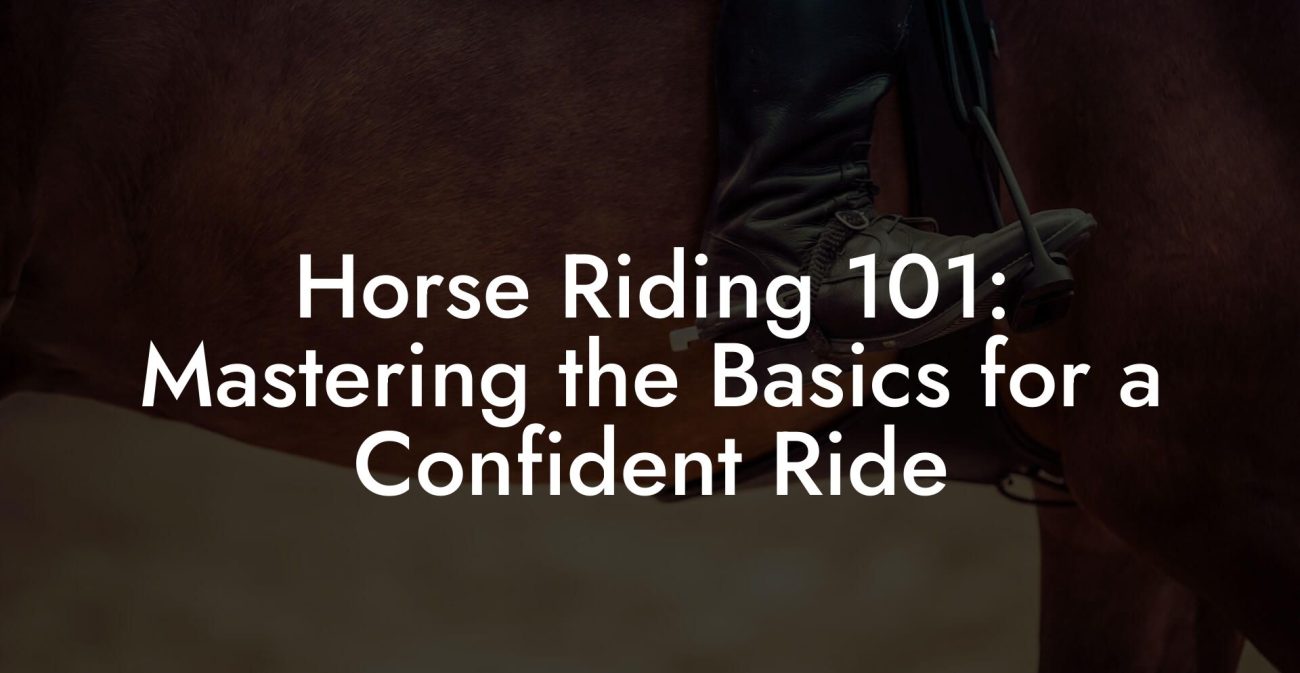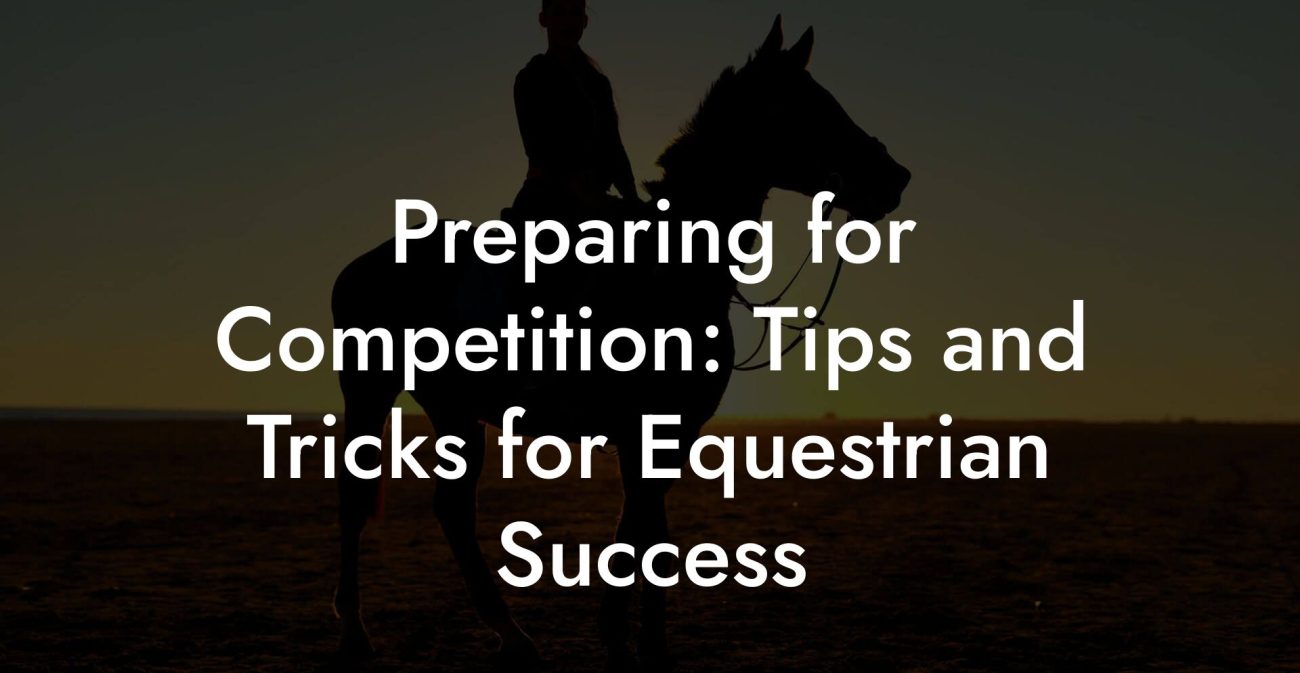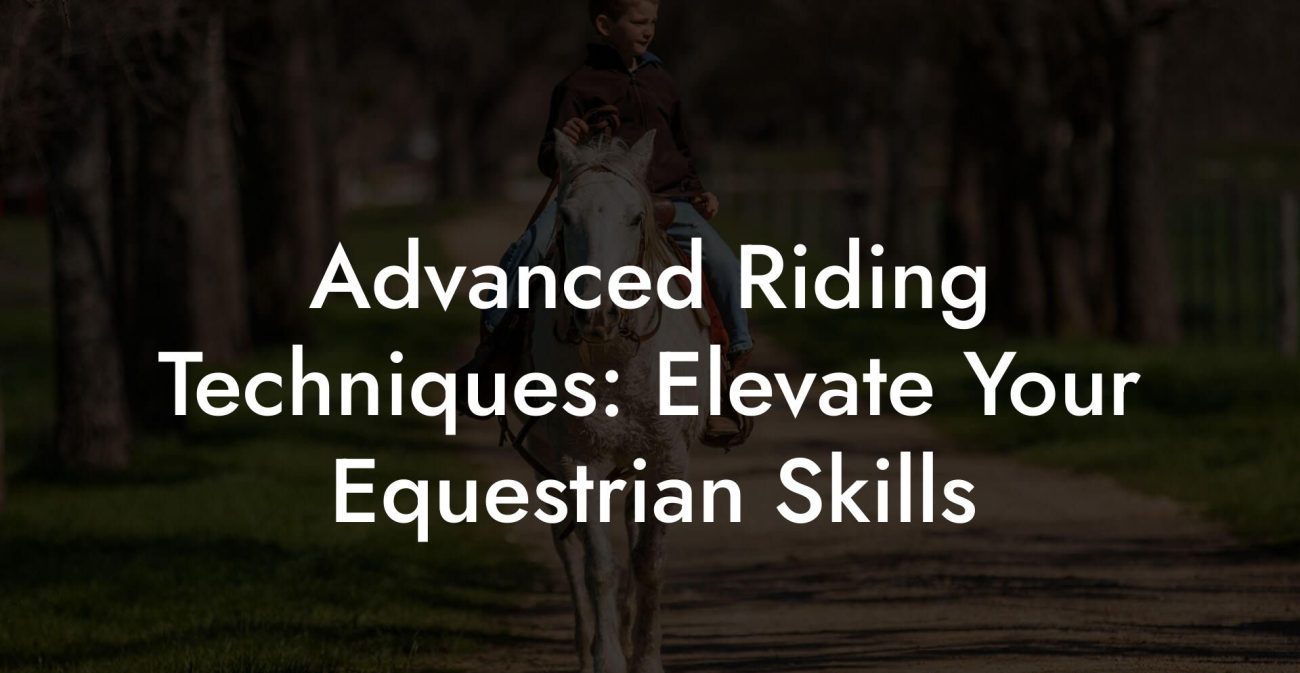Ever wondered how to transform your equine buddy into a lean, mean, performance-enhancing machine while keeping the ride fun and stress-free? Buckle up, no, not the saddle, but your mindset, because we’re about to dive hooves-first into the exhilarating universe of riding exercises designed to enhance your horse’s performance, boost overall fitness, and strengthen the bond between saddle and rider.
Quick Links to Useful Sections
- Understanding the Equine Athlete: Why Riding Exercises Matter
- The Science Behind Equine Fitness: Anatomy, Physiology, and Performance
- The Best Riding Exercises to Enhance Your Horse’s Performance
- 1. Groundwork Drills: Building Trust and Muscle Memory
- 2. Interval Training in the Saddle
- 3. Lateral Movements: Enhancing Flexibility and Balance
- 4. Core Strength and Balance Workouts
- The Mind-Body Connection: Training Beyond Physical Exercises
- Integrating Trendy Technology Into Your Horse’s Workout Regimen
- Practical Riding Exercise Routines: A Week-Long Plan
- Monday: Building the Foundation
- Tuesday: High-Intensity Interval Training
- Wednesday: Lateral Movement and Balance Day
- Thursday: Mind-Body Connection and Recovery
- Friday: Strength and Endurance Training
- Saturday: Technology-Enhanced Performance
- Sunday: Fun and Freestyle
- Balancing Nutrition and Care: Fueling Your Horse for Success
- Expert Riding Tips: Insights From the Pros
- Conquering Challenges: Safety and Precautions in Riding Exercises
- Resources and Community Support: Your Next Steps
- Frequently Asked Questions About Enhancing Your Horse’s Performance
- Your Path to Peak Equine Performance
Understanding the Equine Athlete: Why Riding Exercises Matter
Horses are not just majestic creatures; they’re high-performance athletes built for endurance, strength, and agility. Just like us, these four-legged athletes benefit from a well-rounded fitness routine that incorporates strength training, balance exercises, and mental stimulation. When you invest in targeted riding exercises, you’re not only improving your horse’s physical capabilities but also encouraging better behavior and responsiveness in the saddle.
In the fast-evolving world of equestrian sports and recreational riding, the lines between traditional training and modern fitness regimens are blurring. Today’s riders, especially those from Gen-Z and millennial circles, demand an engaging, holistic, and downright fun approach to horse care. Think of it as merging the coolest workout trends with time-tested equine techniques to yield a healthy, happy, and high-performing mount.
Integrating innovative riding exercises into your routine means embracing a lifestyle that goes beyond mere riding. It involves a commitment to overall horse fitness, proper nutrition, mental wellness, and regular maintenance, all of which contribute to a more dynamic performance on the track, in the arena, or on your daily trail ride.
The Science Behind Equine Fitness: Anatomy, Physiology, and Performance
A deep dive into your horse’s anatomy reveals a fascinating blend of power and grace. The equine musculoskeletal system is designed for both explosive bursts and prolonged endurance. Key areas that benefit significantly from riding exercises include the core, hindquarters, and back muscles. These exercises help in distributing the rider’s weight more evenly, reducing the risk of injury and ensuring maximum comfort during long sessions.
Understanding the biomechanics of your horse is essential. With every stride, your animal’s muscles, joints, and tendons work in perfect harmony. However, the slightest misalignment or imbalance can lead to inefficiencies in movement. A training regimen that includes targeted exercises sharpens muscle coordination and improves joint flexibility. This not only enhances performance but also minimizes the likelihood of strains or overuse injuries.
Moreover, regular riding exercises improve blood circulation and bolster the overall cardiovascular system, enabling faster recovery and a more robust performance on race days, show jumping arenas, or even those leisurely trail rides where every step counts.
The Best Riding Exercises to Enhance Your Horse’s Performance
Now that we’ve established why equine fitness is crucial, let’s saddle up and explore some of the top riding exercises that have taken the equestrian community by storm. These exercises are strategically designed to target different muscle groups, boost endurance, and enhance overall agility in a fun, interactive format.
1. Groundwork Drills: Building Trust and Muscle Memory
Groundwork is the cornerstone of any equestrian routine. By engaging your horse in activities outside the saddle, you build trust and establish a foundation for more advanced exercises. Some effective groundwork drills include:
- Leading and Following Exercises: These basic drills enhance communication. They teach your horse to respond to body language cues and subtle signals, ensuring a smoother transition to riding exercises later on.
- Cavaletti Work: Setting up low obstacles encourages your horse to lift its legs, improving balance, coordination, and flexibility. This exercise not only strengthens the hindquarters but also promotes a light, springy step.
- Yielding to Pressure: Using gentle resistance to encourage your horse to back up or move laterally helps improve responsiveness and muscle tone.
Groundwork drills are like the warm-up your favorite fitness influencer swears by, they set the stage for serious gains by engaging the muscles and sharpening the mind.
2. Interval Training in the Saddle
Just as interval training is a hit in modern gym routines, incorporating bursts of speed followed by recovery periods in the saddle can supercharge your horse’s cardiovascular fitness and strength. Here’s how you can get started:
- Sprint Intervals: Alternate between a fast canter or gallop and a slow trot. This not only improves cardiovascular endurance but also makes your horse more adaptable to changing speeds.
- Hill Repeats: Ascend a gentle slope at a brisk pace and then descend slowly. The incline forces your horse to work harder against gravity, targeting the hindquarters and core muscles.
- Mix and Match: Combine various speed workouts on a track, where changes in pace occur naturally to mimic the dynamic nature of trail riding and competition courses.
Interval training in the saddle transforms routine rides into high-intensity workouts, mixing sweat-inducing bursts with moments of calm that allow muscle recovery. This balance helps in avoiding burnout while still pushing the performance envelope.
3. Lateral Movements: Enhancing Flexibility and Balance
Lateral movement exercises, including leg yields, shoulder-ins, and haunches-ins, are among the best practices to improve your horse’s flexibility, responsiveness, and overall balance. These movements encourage a more supple body that can take corners easier and respond crisply to your commands.
- Leg Yielding: Encourage your horse to move diagonally by gently steering it from one side. This movement increases lateral flexibility and enhances overall control.
- Shoulder-In: Ask your horse to step softly on one side, creating an inward bend. This exercise promotes a more collected frame by engaging the inner thigh muscles.
- Haunches-In: Focus on moving the hindquarters inward while maintaining forward motion. This exercise strengthens the core and bolsters balance.
These lateral workouts not only refine your horse’s movements but also help to correct imbalances that may develop from repetitive motions during regular riding.
4. Core Strength and Balance Workouts
A strong core is the secret ingredient to a high-performing equine body. Similar to human fitness routines, core strength exercises help stabilize the midsection, ensuring every movement is executed with power and precision.
- Half-Pirouettes: Engage your horse in small, controlled circles that require it to balance and pivot efficiently. This exercise targets the oblique muscles and enhances overall coordination.
- Transition Drills: Smooth transitions between different gaits, walk, trot, canter, boost muscle memory and force your horse to engage its core continuously.
- Stretching and Flexibility Routines: Incorporate gentle stretching before and after rides. Stretching not only relieves muscle tension but also promotes elasticity, which is crucial for peak performance.
Incorporating these core and balance workouts into your routine can elevate a routine ride into a comprehensive fitness session that benefits both physical performance and overall equine well-being.
The Mind-Body Connection: Training Beyond Physical Exercises
Riding exercises aren’t just about building muscle and endurance, they’re also a powerful medium for boosting mental acuity and establishing a deep emotional bond with your horse. Modern equestrian training acknowledges that a calm, focused horse will perform better than one bogged down by stress or anxiety.
Mind-body techniques in riding include:
- Mindful Riding: Engage fully in the moment by syncing your breathing with every gallop and canter. This practice not only improves your riding technique but also enhances your horse’s receptivity.
- Visualization: Before a challenging ride, visualize the movements and imagine the perfect execution. This mental rehearsal primes both you and your horse for success.
- Positive Reinforcement: Use verbal cues and gentle touches to reward your horse’s efforts. Building a positive emotional connection can lead to better cooperation and improved performance.
Think of these techniques as the yoga and mindfulness practices of the equestrian world. They keep both the rider and horse relaxed, focused, and ready to tackle any challenge, even if that challenge is a muddy arena on a rainy day.
Integrating Trendy Technology Into Your Horse’s Workout Regimen
In today’s digital age, innovative technology is making its mark on the equestrian world, helping riders track progress, enhance training efficiency, and captivate the attention of a tech-savvy audience. From wearable devices to smart saddle pads, technology is redefining how we monitor and improve equine performance.
Some cutting-edge tech applications include:
- Wearable Fitness Trackers: These devices, designed specifically for horses, monitor heart rate, stride rate, and overall activity levels. Data collected can help customize training routines to meet specific performance goals.
- GPS and Speed Monitors: For those who love to push the limits, GPS units and speed monitors not only record your horse’s pace and distance covered but also map out the best trails for interval training.
- Smart Saddles and Sensors: Equipped with sensors, these tools provide insights into your horse’s posture and balance. By analyzing the data, you can pinpoint areas that require additional support or targeted exercises.
- Mobile Apps and Online Communities: Join digital platforms that allow you to share progress, engage with fellow equestrians, and even consult with professional trainers remotely.
Integrating technology into your riding exercises not only boosts performance but also adds a fun, modern twist that appeals to the Gen-Z and millennial riders of today. Data-driven decisions can elevate your horse training routine from mere tradition to a scientifically optimized regimen.
Practical Riding Exercise Routines: A Week-Long Plan
Ready to hit the stables with a concrete plan? Here’s a week-long riding exercise routine that blends the best of traditional and modern training techniques. Each day is designed to focus on different aspects of equine fitness, ensuring balanced development while keeping the training sessions exciting.
Monday: Building the Foundation
Kick off your week with a focus on groundwork and basic riding exercises. Spend the first half of your session on:
- Warm-Up: 10 minutes of walking and gentle stretching.
- Groundwork Drills: 15 minutes of leading, following, and yielding exercises to set the tone for the week.
- Saddle-Up Session: 20 minutes of a relaxed trot combined with transitions between gaits to sync your horse’s muscle memory.
End with a cool-down walk and a brief stretching routine for both you and your horse, for good measure and a chill-vibe finish.
Tuesday: High-Intensity Interval Training
Time to amp up the intensity with interval training:
- Warm-Up: 10 minutes of walking and light trotting.
- Sprint Intervals: Alternate between 2 minutes of fast canter/gallop and 3 minutes of slow trot, repeated 4-5 times.
- Hill Repeats: If available, find a gentle slope to ride up at a brisk pace and descend slowly, repeating for 10-15 minutes.
This high-energy session boosts cardiovascular fitness and gets those muscles fired up.
Wednesday: Lateral Movement and Balance Day
Midweek calls for refining flexibility and balance.
- Warm-Up: Begin with a 10-minute walk incorporating gentle stretching.
- Lateral Movements: Dedicate 20 minutes to leg yielding, shoulder-ins, and haunches-ins. Practice each exercise across the arena, focusing on smooth, controlled transitions.
- Core Strength: Implement half-pirouettes and transition drills, focusing on steady, balanced movements for another 15 minutes.
This session is as much about honing technique as it is about building your horse’s muscular endurance.
Thursday: Mind-Body Connection and Recovery
A perfect midweek break to reconnect on an emotional and physical level.
- Warm-Up: Start with 10 minutes of a peaceful walk.
- Mindful Riding: Spend 20 minutes in the saddle practicing deep breathing, visualization, and slow, deliberate movements. Focus on the rhythm of your horse’s gait.
- Cool-Down: A gentle walk combined with light stretching for 15 minutes to improve circulation and relax muscles.
Not only does this day provide physical recovery, but it also reinforces a strong emotional connection between you and your horse.
Friday: Strength and Endurance Training
End the workweek with a blend of strength and endurance exercises.
- Warm-Up: 10 minutes of controlled walk and trot.
- Core Strengthening: Focus on exercises like half-pirouettes and slow transition drills for 20 minutes.
- Interval Training Redux: Incorporate a shorter, yet intense, interval session of 15 minutes where you mix canter and trot segments.
This day is all about pushing limits safely while monitoring your horse’s energy levels and stamina.
Saturday: Technology-Enhanced Performance
Integrate some tech-driven sessions today.
- Warm-Up: 10 minutes of walk and stretch with real-time heart rate monitoring.
- Wearable Tracker Session: Use a fitness tracker to monitor your horse’s performance during a 30-minute ride that alternates between varied paces.
- Data Review: Spend 15 minutes reviewing the session metrics via your mobile app, noting improvements and areas for adjustment.
Leveraging modern technology not only adds a cool factor but also helps in customizing training plans for future gains.
Sunday: Fun and Freestyle
End your week with a freestyle ride that incorporates everything learned. This is your time to experiment and let creativity lead the way.
- Warm-Up: A leisurely 10-minute walk and some casual stretching.
- Freestyle Session: Spend 40 minutes riding without a strict plan. Combine intervals, lateral movements, and mindful riding in a relaxed atmosphere.
- Cool-Down: Conclude with a 10-minute cool down and a brief grooming session, because nothing says “I care” like a little extra TLC.
This freestyle day reinforces a fun, stress-free environment while embedding all the core exercises into a routine that feels less like work and more like play.
Balancing Nutrition and Care: Fueling Your Horse for Success
Just like any athlete, your horse’s performance is deeply influenced by its diet, rest, and overall care. A well-balanced nutrition plan geared toward reducing inflammation, maintaining muscle tone, and sustaining energy levels is essential for peak performance.
Here are some key nutritional and care tips:
- Quality Forage: Ensure your horse has constant access to good-quality hay. Forage is a critical part of their diet, providing essential fiber and nutrients that support digestive health.
- Supplemental Nutrition: Consider supplements like omega-3 fatty acids for joint health, vitamins for overall performance, and a balanced mineral mix to keep their muscles functioning at their best.
- Hydration: Maintain proper hydration levels throughout the day, especially during or after intense exercise sessions. Adequate water intake is crucial for muscle repair and general energy.
- Rest and Recovery: Incorporate routine rest days into your training plan. Recovery is where the real muscle remodeling and strengthening happen, so a good night’s sleep and quiet time in the pasture are just as important as the workouts.
Combining these nutritional practices with tailored riding exercises creates a harmonious balance that fortifies your horse’s overall well-being.
Expert Riding Tips: Insights From the Pros
The equestrian community is brimming with professionals who swear by the importance of blending traditional techniques with new-age practices. Here are some pro tips that can elevate your riding exercise routine:
- Mix It Up: Avoid monotony by varying your exercises. The horse’s enthusiasm rejuvenates with change, whether it’s a different route, a novel exercise, or even a fresh training partner.
- Focus on Communication: Substitute harsh commands with positive reinforcement. A satisfied, relaxed horse is more likely to embrace new techniques and improve faster.
- Maintain Consistency: A consistent routine builds both muscle memory and trust. Even when the going gets tough, sticking to your scheduled exercises yields remarkable improvements over time.
- Document Progress: Keep a training log including performance metrics, diet, and behavioral notes. Not only does this help tailor future sessions, but it also serves as motivation by showcasing the journey of improvement.
- Engage in Continuous Learning: Join online communities, follow popular equestrian influencers, and attend local clinics. Knowledge sharing can introduce you to new drills and reinforce the importance of holistic horse care.
Integrating these expert tips into your routine can transform your riding sessions from mundane chores into exciting, growth-filled experiences, for both you and your horse.
Conquering Challenges: Safety and Precautions in Riding Exercises
While the benefits of structured riding exercises are immense, it’s important to navigate the training process with an eye on safety. Just like a well-crafted social media strategy, equine training requires a careful balance of intensity and caution.
Here are some key precautions to keep in mind:
- Consult with Professionals: Before starting any new training regimen, particularly if your horse is new to intense exercises, consult with equine veterinarians or professional trainers. Their insights can help tailor safe, effective routines.
- Gradual Progression: Avoid overwhelming your horse with drastic changes. Incrementally introduce new drills and closely monitor your animal’s physical and mental responses.
- Proper equipment: Ensure that all gear, from saddles to bridles, is well-fitted and maintained. Faulty equipment can lead to injuries or discomfort, negating the benefits of your exercise routine.
- Environmental Awareness: Choose training locations wisely. Uneven surfaces, unpredictable weather, or overly crowded arenas can pose additional risks. A calm, controlled environment encourages safer, more effective sessions.
- Know the Warning Signs: Be vigilant for signs of fatigue, discomfort, or stress in your horse. Sluggish responses, unusual behavior, or signs of pain should prompt an immediate break from training and, if necessary, vet consultation.
By taking these precautions, you not only safeguard your horse’s well-being but also ensure that the training process remains fun, productive, and injury-free.
Resources and Community Support: Your Next Steps
The journey to elevating your horse’s performance doesn’t have to be a solitary one. There is a vibrant community of riders, trainers, and equine enthusiasts eager to share insights, trade tips, and support one another.
Here are some actionable next steps to fuel your journey:
- Online Forums and Social Groups: Platforms like Reddit, Facebook groups, and specialized equestrian forums are brimming with advice, success stories, and scheduled virtual rides where you can learn and share your experiences.
- Workshops and Clinics: Sign up for local or online equestrian workshops. These sessions often feature expert trainers who offer new strategies, advanced techniques, and innovative theories on horse care and riding exercises.
- Follow the Trends: Keep an eye on equestrian influencers and blogs that spotlight the latest in riding exercises, technology trends in horse fitness, and nutritional advice tailored for high-performance equine athletes.
- Join a Riding Club: Whether in your community or virtually, riding clubs offer structured training sessions, friendly competitions, and a supportive network that can help you navigate the ups and downs of equine training.
- Invest in Quality Gear: Look for state-of-the-art equipment and accessories that can enhance your training sessions. Modern smart gear not only ensures safety but often integrates with mobile apps to track progress and offer customized feedback.
Embracing community support and leveraging available resources makes the journey fun and sustainable. Start small, stay curious, and remember, every ride is an opportunity to learn, grow, and celebrate the unique bond you share with your horse.
Frequently Asked Questions About Enhancing Your Horse’s Performance
Here are some common questions and answers that address your concerns about riding exercises and equine performance.
1. What are the best riding exercises to boost a horse’s performance?
The best riding exercises include a mix of groundwork drills, interval training, lateral movements, and core strength routines. These activities improve overall muscle tone, balance, and cardiovascular health, leading to enhanced performance.
2. How often should I incorporate these exercises into my training routine?
For optimal results, aim for a varied training schedule with dedicated sessions 4-6 days per week. Be sure to include rest or low-intensity days, allowing your horse adequate time to recover and build strength.
3. Can technology really help in monitoring my horse’s progress?
Absolutely. Wearable devices, GPS trackers, and smart saddles provide real-time data on your horse’s heart rate, stride, and overall activity levels. This detailed insight allows you to adjust your training strategy and maximize performance improvements.
4. Are there specific nutritional needs for horses undergoing high-intensity exercises?
Yes, nutritional care is integral. Ensure high-quality forage, supplements like omega-3s for joint health, and plenty of water and minerals to sustain energy and accelerate muscle recovery.
5. What precautions should I take to avoid injuries during these sessions?
Always consult with a professional trainer or veterinarian when introducing new exercises. Use properly fitted equipment, gradually increase intensity, and monitor your horse for any signs of distress to prevent injuries.
6. How can lateral movements improve my horse’s performance?
Lateral movements boost flexibility, balance, and engagement of core muscles. Exercises such as leg yielding and shoulder-ins help correct muscular imbalances and build a more supple, responsive horse.
Remember, every horse is unique. Tailoring the exercises to your horse’s specific needs is key, and a mix of traditional methods with modern technology emerges as the winning formula.
Your Path to Peak Equine Performance
Embracing the best riding exercises isn’t just a training regime, it’s a transformative journey that enhances your horse’s physical prowess, mental acuity, and overall well-being. By integrating innovative fitness routines, modern technology, and a holistic nutritional plan into your equine care strategy, you set the stage for sustained performance improvements alongside a healthier, happier companion.
Every ride is an opportunity to refine technique, celebrate progress, and deepen the connection with your horse on both a physical and emotional level. Remember, the true magic lies in the details, whether that’s a well-timed lateral movement, a perfectly executed interval sprint, or a motivational pat on the neck that solidifies your horse’s trust.
Your journey toward peak equine performance begins with small yet consistent steps. Embrace the thrill of innovation, relish the satisfaction of progress, and never stop exploring new ways to boost your horse’s strength and agility. With dedication, creativity, and a dash of humor, you’ll soon witness your horse evolving into the high-performance athlete that you always knew it could be.
So gear up, saddle in, and prepare to transform routine rides into extraordinary experiences, because excellence in riding exercises is a journey that empowers both you and your majestic partner to reach new heights.





